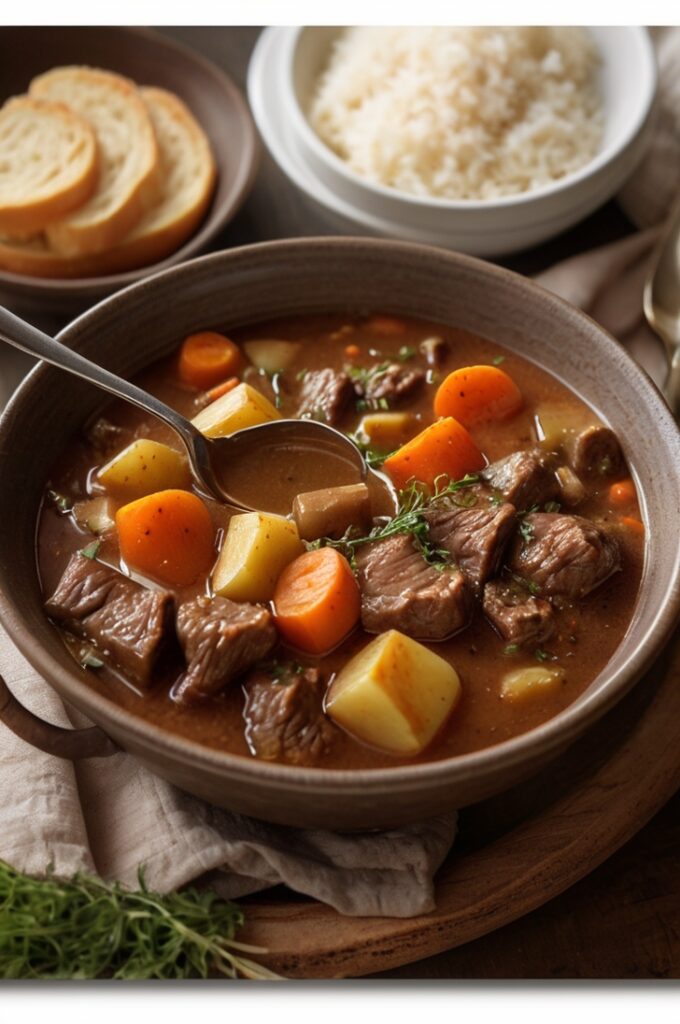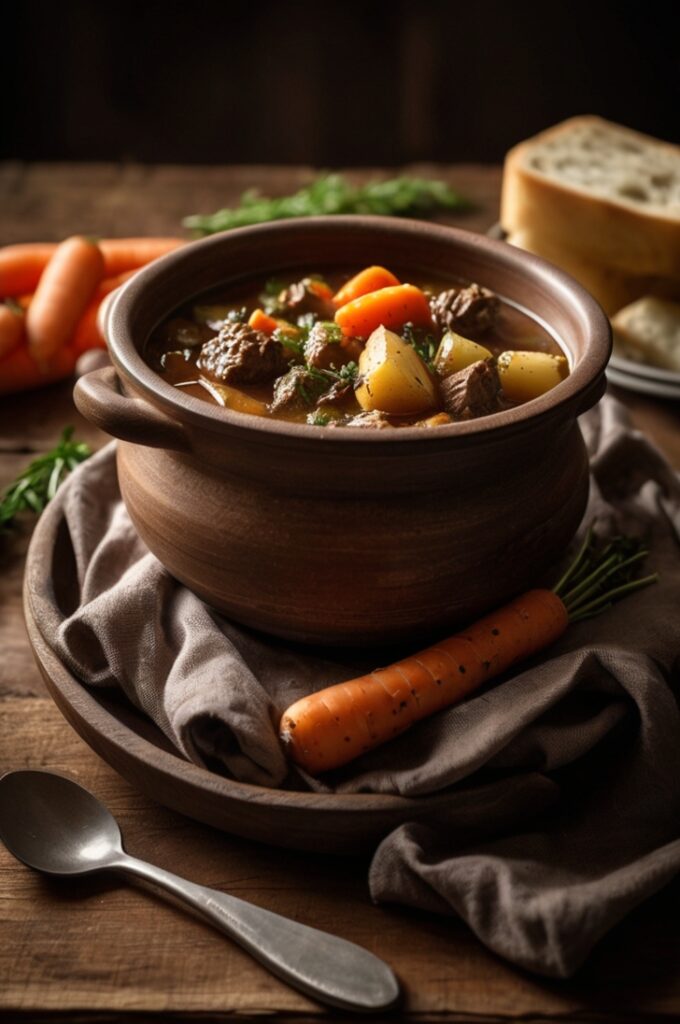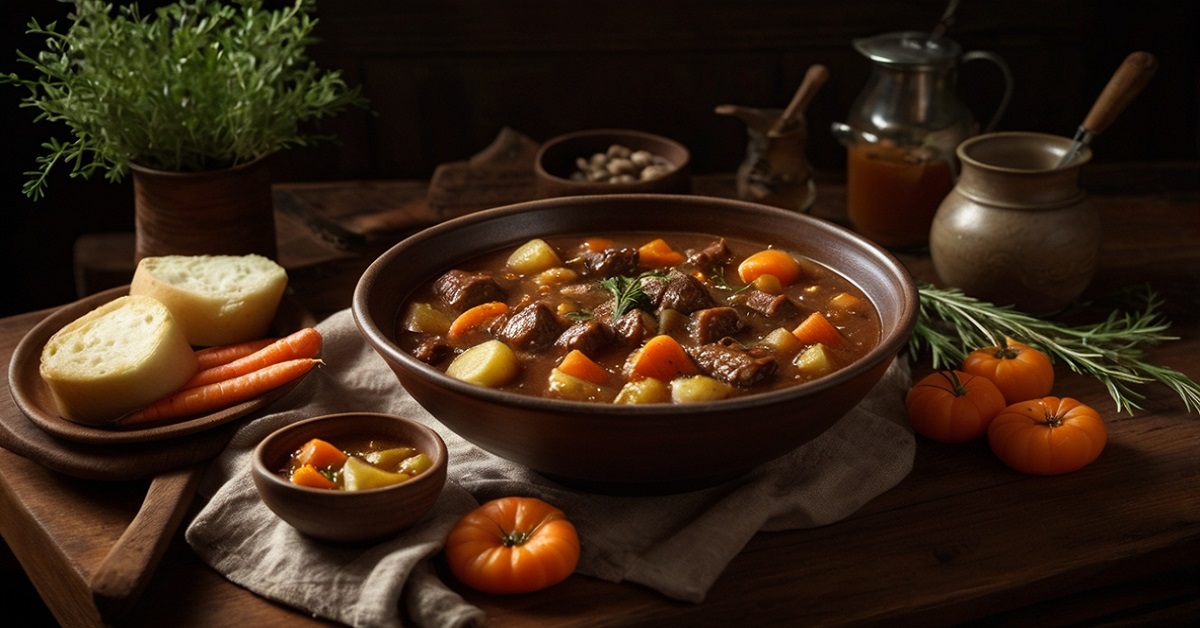Hearty Classic Beef Stew for Cold Nights Recipe ever noticed how certain dishes just wrap you in a warm, cozy hug on a chilly night? For me, that’s gotta be a good ol’ beef stew.
There’s this primal satisfaction watching those thick chunks of beef slowly melt into tender, fork-friendly morsels, swimming in a rich, savory broth. The kind of dish that’s not just food, but a story slow-cooked memories passed from kitchen to kitchen.
Today, I wanna take you deep into the craft of making a classic beef stew that’s hearty enough to fend off the coldest nights, yet refined enough to impress any serious cook.
What Makes This Beef Stew Recipe Special?

This ain’t your rushed stew slapped together in an hour. No sir. This recipe relies on a slow, deliberate process that teases out layers of flavor through classic French-inspired braising techniques, but with a twist of rustic homestyle comfort.
The secret? Starting with quality cuts, layering with fresh herbs, and finishing with a velvety gravy that clings to each tender bite. It’s the kind of stew that demands patience but rewards with deep, complex umami that hits your soul.
We’ll break down ingredient choices that elevate this from everyday to extraordinary. And I’ll drop some professional tips that even seasoned chefs might overlook stuff that’ll make your stew sing. So, grab your heavy pot and let’s get into it.
Ingredients & Substitutions
Beef Chuck Roast (2 lbs, cut into 1.5-inch cubes): This cut is king for stew well-marbled, with enough connective tissue to break down into tender gelatin. Avoid leaner cuts like sirloin, which dry out and toughen in long cooking.
Vegetables:
- 3 large carrots, peeled and sliced thick
- 3 celery stalks, diced
- 1 large yellow onion, roughly chopped
- 4 cloves garlic, minced
- 4 medium Yukon Gold potatoes, peeled and cubed
Liquids:
- 4 cups beef stock (homemade preferred for depth)
- 1 cup dry red wine (optional but highly recommended for complexity)
Thickening Agents:
- 2 tablespoons tomato paste (adds acidity and richness)
- 3 tablespoons all-purpose flour or cornstarch (see below)
- 2 tablespoons butter (for finishing)
Herbs & Spices:
- 2 sprigs fresh rosemary
- 3 sprigs fresh thyme
- 2 bay leaves
- Salt and freshly ground black pepper, to taste
High-Quality Substitutions
- For gluten-free: Swap all-purpose flour for cornstarch or arrowroot powder. Add it as a slurry near the end to avoid clumping.
- For low sodium: Use unsalted beef stock or dilute with water, then adjust seasoning carefully near the end.
- Vegetable swaps: Parsnips or turnips add lovely earthiness in place of potatoes. Sweet potatoes can add a hint of sweetness, but adjust cooking time as they break down faster.
- Wine alternative: If you prefer no alcohol, a splash of balsamic vinegar or extra beef stock works in place of wine, but expect less depth.
Ingredient Selection Insights
Fresh herbs? Absolutely. They offer brighter, more vibrant notes than dried. But dried thyme or rosemary can step in if fresh’s not available just halve the amount. Also, choosing Yukon Gold potatoes over Russets is intentional. Yukon Golds hold shape better during long cooking and add buttery flavor.
And the tomato paste it’s not just a filler. It boosts the stew’s umami profile and balances richness with subtle acidity. Don’t skip it or use ketchup instead, that’ll throw off the flavor.
Step-by-Step Instructions
Step 1: Prep and Brown the Beef
Pat the beef cubes dry with paper towels moisture is the enemy of a good sear. Heat a heavy-bottomed Dutch oven over medium-high heat, add a splash of oil, and brown beef in batches. Crowding the pan will steam the meat instead of browning it, so take your time. Browned meat = flavor goldmine, so don’t rush or skip this.
Step 2: Sweat the Veggies
Remove beef, lower heat to medium, and add onions, carrots, and celery to the pot. Cook until soft and slightly caramelized, about 8 minutes. Garlic goes in last, just a minute or so, so it doesn’t burn.
Step 3: Deglaze and Build Flavor
Add tomato paste, cook a minute more, then pour in the wine. Use a wooden spoon to scrape up those beautiful browned bits stuck to the pot bottom. This step’s critical those bits are packed with flavor and build the stew’s base.
Step 4: Braise the Beef
Return beef to the pot, pour in beef stock until it just covers the meat and veggies. Toss in herbs, bay leaves, and season with salt and pepper. Bring to a gentle simmer, then cover and transfer to a preheated 325°F oven for 2.5 to 3 hours. Alternatively, keep simmering on the stove on low. Slow braising melts connective tissue and infuses flavor throughout.
Step 5: Add Potatoes and Finish Cooking
After the initial braise, add the potatoes and cook until tender, about 30–40 minutes more. Remove herbs and bay leaves.
Step 6: Thicken the Stew
Make a slurry with flour and cold water or broth. Stir it in and simmer on low until the sauce thickens and coats the back of a spoon. For extra richness, swirl in butter right at the end.
Common Mistakes and How to Avoid Them
- Skipping the browning step: You’ll miss out on that deep, roasted flavor. Always brown your meat.
- Overcrowding the pot: Crowding leads to steaming, not searing. Brown in batches.
- Adding potatoes too early: They’ll mushify if left too long in the stew. Add them later for that perfect bite.
Variations
Want to punch up heat? Toss in a pinch of cayenne or smoked paprika during the tomato paste step. Feeling adventurous? Stir in a splash of Worcestershire sauce or soy sauce for a subtle umami boost.
Cooking Techniques & Science
Searing beef is more than just tradition it triggers the Maillard reaction, creating complex flavor molecules and giving that nutty, browned aroma. This crust locks in flavor, though not exactly juices meat actually loses moisture during cooking, but the crust creates layers of taste.
Braising in liquid at low temperatures breaks down collagen in tough beef cuts, turning it into gelatin. This gelatin enriches the broth, giving it that luscious, silky mouthfeel. Cooking low and slow also allows flavors to meld and intensify naturally.
Choosing a heavy Dutch oven is key. Its thick walls distribute heat evenly and retain moisture better than thin pans. It creates an ideal micro-environment for braising.
Deglazing releases flavorful bits stuck to the pan’s bottom (fond). These bits dissolve into the liquid and add a richness you just can’t fake with store-bought stock alone.
Serving & Pairing Suggestions

Serve your beef stew in deep bowls to hold every luscious bite. Garnish with fresh parsley or thyme for a pop of color and freshness. A rustic crusty bread or a creamy mashed potato side can mop up that gorgeous gravy.
Pair this stew with a robust red wine like Cabernet Sauvignon or Syrah. If you’re more of a beer person, a malty brown ale or porter complements the dish’s hearty flavors.
For a fancy touch, finish with a dollop of crème fraîche or a sprinkling of grated horseradish for a sharp contrast.
FAQs About Hearty Classic Beef Stew for Cold Nights Recipe
Q: Can I use a slow cooker for this stew?
A: Absolutely. Brown your beef first, then transfer everything to the slow cooker. Cook on low for 7–8 hours or high for 4–5 hours. Add potatoes during the last hour.
Q: How do I store leftover beef stew?
A: Cool quickly and refrigerate in an airtight container for up to 3 days. Freeze for up to 3 months. Reheat gently on stovetop, adding broth if needed.
Q: Can I use stew beef instead of chuck roast?
A: Stew beef is usually trimmed and leaner. It can dry out easier. Chuck roast has better fat and connective tissue content for tender results.
Q: What if my stew is too thin?
A: Make a slurry with flour or cornstarch and a little water, stir it in, and simmer until thickened.
Q: Can I add other vegetables?
A: Yes! Mushrooms, parsnips, or pearl onions all work well. Add according to their cooking times to avoid mush.
If you’re looking to master a beef stew that warms from the inside out, this recipe’s your ticket. Get your pot ready, and let the slow magic begin.
Conclusion
This classic beef stew isn’t just food it’s comfort, craft, and tradition all in one pot. The magic is in the slow braise, quality ingredients, and the layers of flavors you build step by step. It’s a dish that stands up to the coldest nights, a hug in a bowl, and a testament to patience in the kitchen.
Remember: dry your beef before browning, don’t rush the braising, and always taste for seasoning near the end. Play with the recipe, add your own twist. This stew’s versatility is what makes it timeless.
So next time the temperature dips, slow-cook yourself some cozy goodness and savor every bite.




